Pros
Cons
Physical Tour
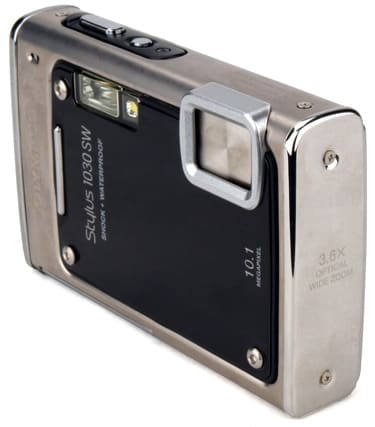
Front(8.00)
With visible screw heads reinforcing its tough-gear image, the front of the 1030 SW features a glossy panel (available in silver, green or black) inset in a brushed metal body. At the far left is a shiny metal band and, to the right, the word OLYMPUS embossed vertically into silver brushed metal. Above the word are two small holes for a stereo microphone. To the right, as the glossy panel begins, there’s a thin raised silver bar that lines up with your middle finger while holding the camera. Above and below this bar are two of the visible screws. The words STYLUS 1030 SW and, below that, in smaller letters, SHOCK + WATERPROOF, are printed vertically in silver ink. Above these words is the small horizontal flash and, next to that, the LED illuminator, which serves both as an auto focus assist lamp and a self-timer indicator. The lens is located at the top right, behind a lens cover that automatically raises and lowers when power is turned on and off. Below this, again in silver ink printed vertically, is the legend 10.1 MEGAPIXELS.
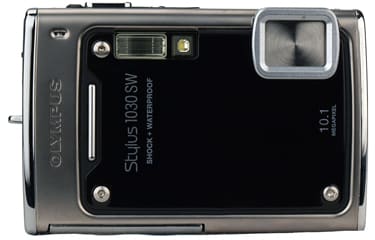
The rugged construction of the 1030 SW
is reflected in its design.
Back (7.00)
The back of the 1030 SW gets pretty busy on the right side, but it starts simply enough, with two small raised dots top and bottom to give the LCD screen some clearance when the camera is laid flat. The LCD screen measures 2.7 inches, with a 230,000-dot resolution. Underneath the screen, printed in white on the brushed silver metal, is OLYMPUS HyperCrystal LCD.
The area to the right of the screen fairly bristles with buttons and other controls. At top are the zoom lens controls, with a raised metal dot between them for no particular reason. During playback the W button does double duty as the thumbnail display control, while the T controls on-screen magnification. The mode dial below these buttons clicks into eight positions, some indicated by icons, others with text labels. These are, moving clockwise, AUTO, Program (the camera icon), Anti-shake (the wavering hand icon), SCN (scene modes), GUIDE (on-screen text shooting guide), Movie mode (the camera icon), Favorites playback (the star icon) and Play (the standard VCR-style icon). To the left of the wheel is a small lamp that flashes when the memory card is being accessed.
In the bottom right quadrant is a four-way controller, with four small silver buttons tucked into the four corners. In addition to maneuvering through on-screen menus, each directional wing of the four-way controllers has a secondary control function while shooting: exposure compensation (top), self-timer (bottom), flash (right) and macro mode (left). As for the four inset buttons, they control (clockwise, from top left) menu, review/direct print, backlight compensation/erase, and display/help/LED illuminator.
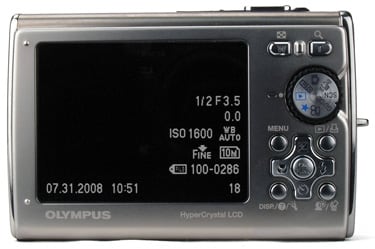
All the controls are clustered on the right.
Left Side* (5.00) *The left side doesn't do much, beyond reminding you in white lettering on a polished metal backdrop that the camera has a 3.6X OPTICAL WIDE ZOOM lens. Once again, the panel is highlighted by two tiny Philips-head screws you'd best leave alone.
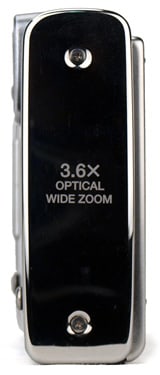
Not much to see here, but you could use the
reflective surface as a mirror.
At the top is a firmly latched cover concealing the multi-connector, a proprietary cable port used for the supplied USB and AV cables. The latch itself is stiff enough to prevent accidental opening but doesn't fight back unreasonably when pushed down with a fingernail. Inside the drop-down cover is a rubber gasket providing additional protection against water invading the electrical connector.
Below the door is a protruding silver loop for connecting the supplied wrist strap. The strap end is thin, the loop is large and wide open, so making the connection is simple.
The lower third of the right side is taken up by a small speaker, flanked by two screws top and bottom.
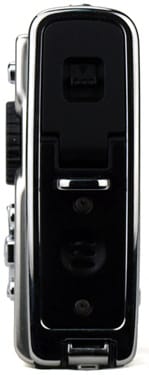
The top door snaps shut **tightly,*
reinforced with a rubber gasket.
*
The top of the camera is simple and attractive, with nicely rounded edges front and back and an inset black panel for the two controls: the round power button and the rounded rectangle shutter. The shutter lacks the clear two-step progression found on many other cameras, where you feel a slight click when you hit the half-depressed state and then the full shutter release. Here you know you've hit the halfway point when you hear an annoying beep – we'd rather silence the sound and work by feel.
On the right side of the top is the legend OLYMPUS AF WIDE ZOOM 5.0-18.2mm 1:3.5-5.1. The top of the lens housing juts out a few millimeters in front. And flanking the left and right side, predictably, are two screws, with a third inset into the black panel.

*The different button sizes and shapes make it
easy to distiguish between them by touch.*
The camera can stand securely on the wide, flat bottom. At the left is a label with the camera model name and serial number. Slightly off-center toward the left is a tripod socket, made entirely out of plastic and frighteningly fragile if you’re actually planning to use a tripod with any frequency. There’s a visible screw above the tripod socket. Next is the latch for the battery and xD card slot cover. The latch release requires a fingernail to catch it, but when it snaps shut it does so with authority (good thing, since it’s expected to protect the camera innards to a 30-foot depth). Inside the door is a black rubber gasket to ensure a waterproof seal.

*The plastic tripod socket feels flimsy.
*
Testing/Performance
We put the 1030 SW through our standardized battery of tests designed to tease out the performance peculiarities of an individual camera, and to provide a statistical basis for comparison across all the cameras we review. We compared the 1030SW performance against a range of cameras, some in the same price range, some significantly less expensive. The bottom line: the automatic systems do a reasonable job producing acceptable images, but there are shortcomings in key areas, notably white balance and continuous shooting speed.
**Color **(5.50)
When we test color performance, we stress accuracy – how well the camera reproduces real-world shades. In the end, you may decide to tweak the photo using image editing software to achieve richer, deeper colors that pack more dramatic impact. For starters, though, we value cold, clinical accuracy, judged not with the naked eye but using an image analysis program called Imatest. We shoot an industry-standard Gretag Macbeth color chart under controlled studio lighting, then use Imatest to compare the colors captured by the camera with the known color values in the standard chart. And based on our testing of the 1030 SW, with color accuracy less than impressive, Olympus decided to pump up the color intensity in an effort to convince users they’re getting more visual bang for their buck. The color chart below represents the best the 1030 SW could achieve. The original chart color is shown in the small vertical rectangle on the right in each box. The captured color, corrected for luminance, is shown in the inner square, and the color captured by the camera by the outer rectangle.
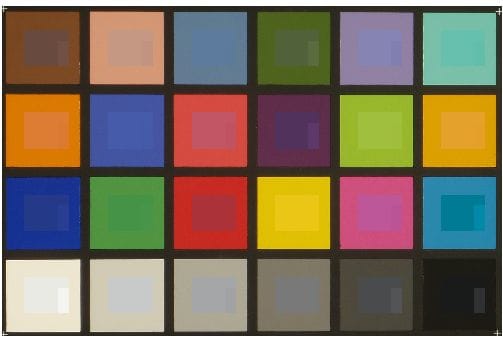

The difference between the captured and ideal colors is clearly visible here, particularly in the red, pink and brown squares. The follow Imatest result chart helps isolate where these differences occur. The ideal values are represented by the squares, the colors the camera captured are shown by the circles. And the lines connecting the two indicate just how much color variation was introduced by the camera.
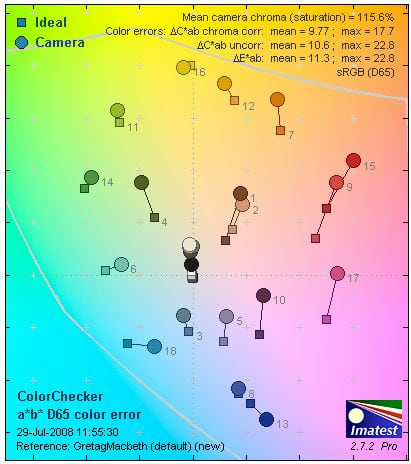
The shorter the lines in this chart, the more accurate the color.*
*
In this case, the blues and greens are quite accurate, the reds and oranges off by a wide margin. The other result that stands out here, though, is 115.6% saturation – as you might expect, 100% is the optimum number here. While the results here were achieved at ISO 80, the camera’s lowest setting, the scores for both color accuracy and oversaturation were very consistent across the ISO spectrum. Years ago, in his song 'Kodachrome,' Paul Simon celebrated the famously oversaturated film stock: "They give us those nice bright colors, they give us the greens of summers, make you think all the world’s a sunny day." Clearly the beat goes on in the Olympus engineering lab.
Olympus Stylus 1030 SW Color Scores
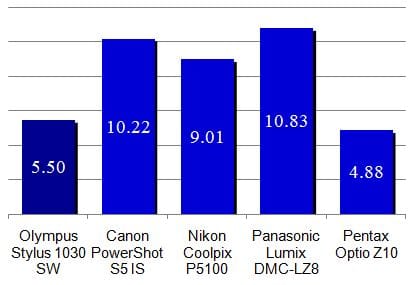
Compared to other compact digital cameras, the Stylus 1030 SW color performance lags behind most of the competition, including the Panasonic that sells for less than half as much. Only the Pentax Optio Z10 scored lower in our testing.
There’s significantly more joy in Olympus-land when it comes to resolution testing, where the 1030 SW delivered a very credible performance. To test resolution, we shoot an industry-standard resolution chart (below) at several focal lengths, then analyze the images with Imatest software to derive a resolution reading in line widths per picture height (lw/ph). This figure indicates the number of individual, progressively thinner horizontal and vertical lines the camera can pick up before the pattern deteriorates into an undifferentiated grey splotch.
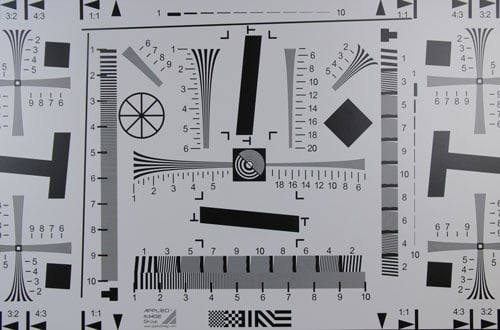
The industry-standard resolution chart we use for testing
The 1030 SW managed a top score of 1688 lw/ph horizontally and 1497 vertically, with slight undersharpening, in the middle of the lens’ zoom range. The scores at the wide-angle end of the range were not far from this result, though higher telephoto settings sank resolution scores by a noticeable 12-13%. While this kind of performance would be unimpressive for a digital SLR, it stands up very well against the point-and-shoot competition.
Olympus Stylus 1030 SW Resolution Scores
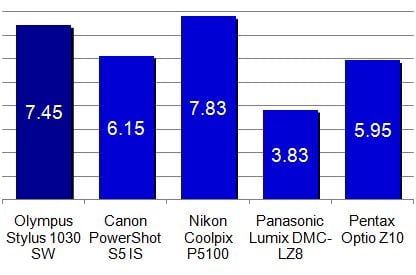
Noise – Manual ISO*(6.66)*
For film photographers the problem was grain, the random texture caused by the distribution of fine metallic particles on the film stock, which grew more noticeable the more you pushed film to handle low-light shooting situations. For digital photographers, the problem of random noise remains, though the name, and the source are different. The undesirable texture in digital photography is called noise, caused by imperfections in digital image sensors compounded by processing variables in turning the captured light into digital 1s and 0s. As with film, the texture is most noticeable in shots taken in low-light situations, with long exposure settings and in areas of flat color, where minor variations are more noticeable.
We test noise performance by shooting the standard color chart at a range of ISO settings, then running the results through Imatest to determine the noise imperfections present at each illumination level. These results are graphed to reveal the rate at which noise increases as ISO setting rise. These results are shown in the graph below, with the percentage of noise shown along the left axis, the ISO levels along the bottom.
Olympus 1030 SW Manual Noise
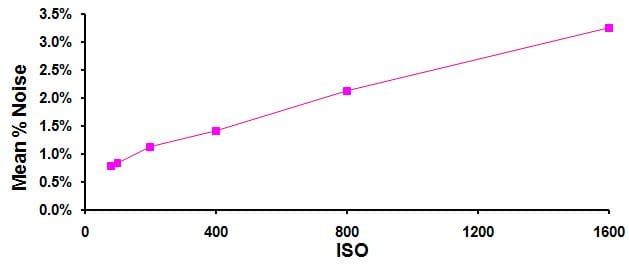
The slope of increasing noise shown here is less than ideal, with a noticeable jump after ISO 200 and a fairly rapid rise from ISO 400 on. However, the noise performance at the more commonly used ISO settings of 80, 100 and 200 start out quite low, leading to a strong overall score. It's worth noting that the camera is equipped with digital noise reduction processing, but the user has no control over its function: it kicks in automatically for exposures longer than half a second in night scene modes.
Olympus 1030 SW Manual Noise Scores
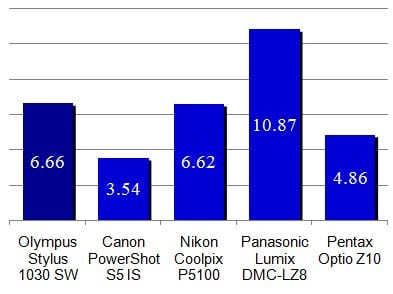
Auto Noise (2.98)
For our auto noise test, we use the automatic ISO mode, letting the camera’s metering system choose the optimal setting in our well-lit studio. While our auto noise test measures the same image parameters as the manual test, the deciding factor separating the winners and losers here is almost always the ISO setting the camera chooses. When the camera chooses an appropriately low ISO, the auto noise scores are generally high. In this case, the 1030 SW decided to shoot at ISO 200, leading to a good score when compared to the Canon, Nikon and Pentax, surpassed only by that consistently strong Panasonic noise performance.
Olympus 1030 SW Auto Noise Scores
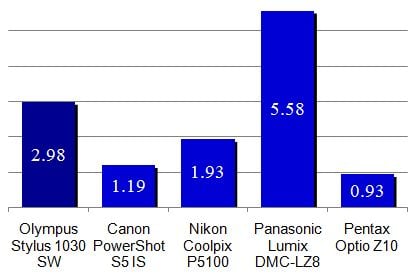
White Balance (5.68)
White balance adjustment proves to be a particularly difficult challenge for digital cameras, particularly point-and-shoot models. We don’t ordinarily notice the different colors of light produced by difference sources, since our minds adjust to perceive the reddish-yellow color of sunlight and the green-tinged fluorescent glow as white. When capturing a photo, though, the camera’s digital processing has to make the adjustment for us, shifting the balance of colors to recreate the white color we perceive.
To test white balance performance, we shoot our standard color chart under four different types of illumination: flash, shade, fluorescent and tungsten (light bulbs), testing the resulting images using Imatest software to compare the results against the original color chart values.
We set the 1030 SW to automatic white balance, allowing the metering system to determine the appropriate setting, and shot at the camera’s lowest ISO setting. Imatest analyzed the resulting images and produced the charts below. Note that the images shown here intentionally exaggerate the differences in white balance to indicate the type of color shift you’d experience rather than the amount of color shift you’d see in your own photos.
-
*There are problems here pretty much across the board, with the shots taken in shaded daylight and under tungsten illumination producing particularly inaccurate results.
*Preset (7.13)
*Most digital cameras also offer the option to manually set white balance to match current lighting conditions and the 1030 SW, despite its limited manual controls, is no exception. There is no preset for flash photography, but there are three settings for fluorescent light. We shot using all three and scored the best result.
Using presets produced noticeably improved results for shots taken in the shade, and upgraded the fluorescent light images from very good to exceptionally accurate. Results using the tungsten preset, though, actually became worse when using the preset, a situation we’ve encountered several times before. By and large, tungsten lighting is the most difficult challenge for digital cameras, particularly inexpensive point-and-shoots, and the 1030 SW is no exception.
Compared to our other test cameras, the Stylus 1030 SW underperforms the pack, only slightly exceeding the score turned in by the Panasonic. In real-world photography, this means you're more likely to notice a slight color cast in your photos when shooting with the Olympus.
Olympus 1030 SW White Balance Scores
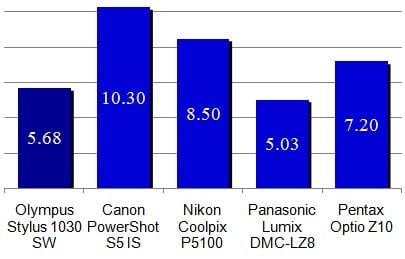
Still Life
To provide a consistent basis for comparison from review to review, we always shoot two still life setups, our happily married couple and Rosie the Riveter and friends, under standard fluorescent lighting with the camera set on full auto, at each available ISO setting. Click on the images below to open the full-resolution originals in a separate browser window, but be prepared to wait: these are large files, and can take a while to download.
**Low Light **(7.39)
The ability to shoot without flash is always valuable – we often find ourselves in situations where flash would ruin a candid situation, wake the baby, and/or result in harsh, unattractive lighting. This becomes especially important with the 1030 SW, with a small, underpowered built-in flash and no way to attach an external flash unit.
We ordinarily undertake two kinds of low-light testing. In the first, we shoot the color chart at four illumination levels, ranging from 60 lux (roughly normal room lighting) down to 5 lux (the illumination given off by a single candle), shooting at ISO 1600.
As seen above, the 1030 SW performed well under a range of lighting levels, with only minimal shifts in color captured under different conditions.
Our second low-light test requires long exposures at ISO 400. Unfortunately, with no manual shutter or aperture control, it was impossible to control exposure times (which ordinarily stretch from 1 second to 30 seconds in our testing) for the 1030 SW. We did shoot under test conditions at ISO 400, allowing the camera to pick the shutter speed (1/2 second). The resulting image showed good color accuracy and an acceptable level of noise.
Overall low light performance for the 1030 SW was in line with the better results we’ve seen in previous compact camera testing. That means you'll have good luck shooting without flash indoors, and is especially welcome in a camera designed for underwater photography, where light levels are always muted.
Olympus 1030 SW Low Light Scores
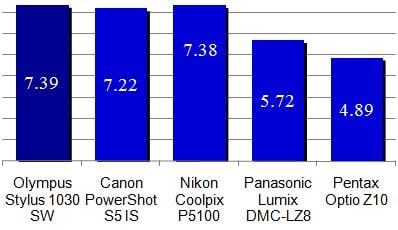
Dynamic Range (6.78)
Dynamic range is the breadth of exposure values a camera can capture, from very bright to deeply shadowed areas, without losing detail. We test this parameter by shooting an illuminated chart with clearly defined steps ranging from pure white to jet black, then run the resulting images through Imatest to determine how broad a range the camera successfully reproduced. The 1030 SW did well here, starting with a good EV range of 7.66 and losing dynamic range as lighting decreased, as expected, but with no precipitous drops.
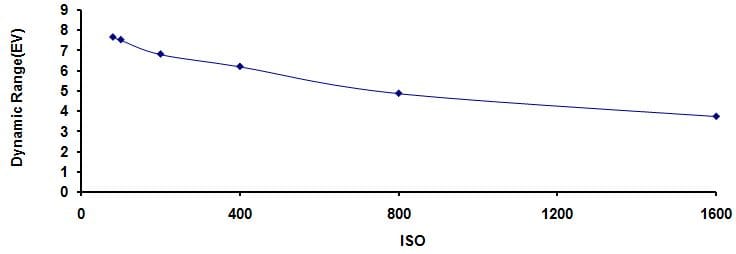
The chart below shows the 1030 SW delivered dynamic range performance when compared to all four of our other examples. Combined with high scores in our resolution testing, this bodes well for the camera's ability to take richly detailed images.
Olympus 1030 SW Dynamic Range Scores
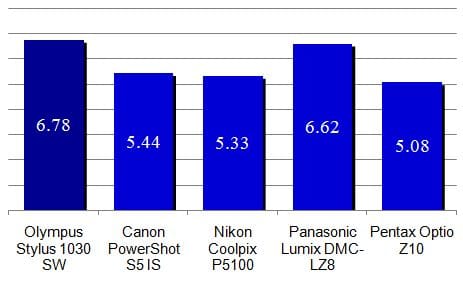
**Speed/Timing
**All speed tests were conducted with an Olympus 2-gigabyte xD PictureCard, with images shot at the 10-megapixel, fine quality setting.
**Startup to First Shot **(5.6)
We measure the time it takes to power on the camera and squeeze off your first shot. With an average of about a second and a half elapsed time, the 1030 SW exhibited acceptable performance: not as fast as the Canon PowerShot S5 IS or Pentax Optio Z10, but not slow enough that it’s likely you’ll miss a shot waiting for your camera to awaken. **
Shot-to-Shot (1.00)
Olympus promises modest burst-mode performance, and that’s exactly what the camera delivers. The spec is 0.7 frames per second for seven consecutive frames at full 10-megapixel resolution; our testing results actually came out a hair faster, at nearly 0.8 frames per second, but that’s still not going to help much when trying to shoot a fast-action sequence. There is also a high-speed mode promising 5.2 frames per second for 11 frames, but limited to 3-megapixel resolution.
Shutter-Shot** (5.70)
In modern digital cameras, the delay between the moment you hit the shutter to the moment the photo is actually taken is far shorter than the excruciating pause common a few years ago, but there are still measurable differences between cameras. The 1030SW clocked a consistent delay of roughly a third of a second, a respectable result.
Processing(8.33)
Here we measure the elapsed time between the moment you take a photo and the moment that photo is displayed on the camera’s LCD screen for review. The 1030 SW performed exceptionally well here, taking only about one second between shutter and review, a significant win over competitive models.
Video Performance (5.52)
Movie capture is available at two resolution settings, 640x480 and 320x240, each at either 15 or 30 frames per second, captured in storage-hungry Motion JPEG format. You also have your choice between Non-Water Movie and Underwater Movie mode, the latter offering three custom white balance settings for different hues of briny blue. We chose not to flood our labs, though, and tested on dry land, at the highest resolution and frame rate. The results weren’t awful, but the 1030 SW is certainly no substitute for a family camcorder.
Bright indoor light – 3000 Lux
We illuminate our color chart very brightly using two large studio lamps to help the camera achieve its optimal video performance. Still frame grabs are then analyzed using Imatest to judge color accuracy. On balance color accuracy here was roughly in line with the performance we saw when testing the camera in still mode, albeit working here at a faster frame rate and radically reduced resolution. Not great, not awful.
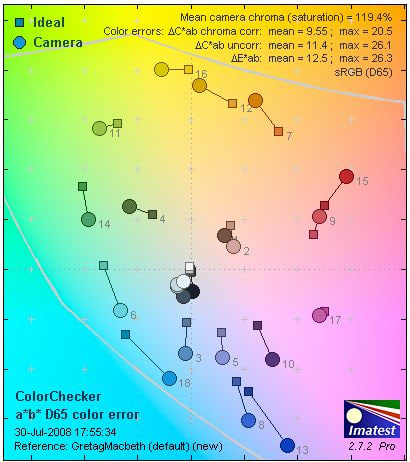
Low light – 30 Lux
Interestingly, when it comes to color reproduction, this camera seems to like low light settings, whether in still or video mode. Color accuracy dipped very little as we dimmed the lights, though color saturation tumbled from noticeably oversaturated at nearly 120% to distinctly undersaturated at just under 80%, making the video look dull overall.
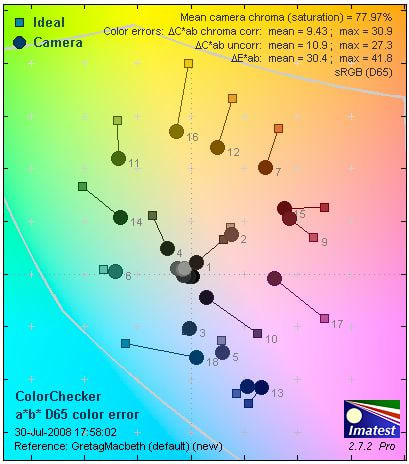
Resolution *(1.27)
*While the 1030SW did reasonably well in color performance, the resolution of captured video was poor, topping out at just 376 lw/ph horizontally and 306 lw/ph vertically. At this level fine details are effectively lost, edges are imprecise and the video displays an overall murky look.
Motion
To test for motion performance we head for the nearest busy street and shoot cars as they drive by, trying to look as much as possible like we’re holding a speed gun to discourage misbehavior among motorists. On a sunny day the moving cars appeared distinct and well defined, without visible blurring. However, looking more carefully at the video to try and pick out details like license plates, bumper stickers and even the heads of passengers inside proved frustrating. This lack of detail isn't surprising, though: video from a point-and-shoot camera just can't compare to a dedicated camcorder (not yet, at any rate).
Components
Viewfinder*(0.00)
The 1030 SW doesn't offer an optical viewfinder. If you were hoping to squeeze a few extra shots from a dying battery by switch off the LCD display, you're out of luck.*LCD Screen**(4.50)
The 2.7-inch display, with a 230,000-dot resolution, looked dim at its default settings. Five brightness settings are available through the setup menu and, by cranking it up all the way, we achieved an acceptable on-screen display for indoor use. Out in bright sunlight, though, the screen was hard to see even at its brightest setting, a particular problem in a camera with no optical viewfinder. On the plus side, color reproduction is quite accurate, and the off-axis viewing angle is better than most point-and-shoots, making it easier to grab a shot with your arm extended.
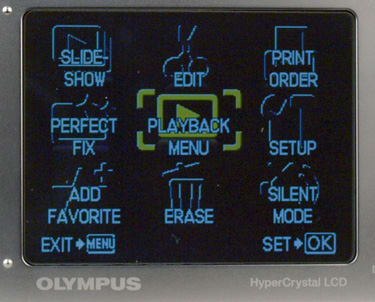
The on-screen menu display is consistently crisp and easy to read, with large clean san serif type and bright yellow highlighting to indicate the cursor position when moving through menu choices. As a fun little personalization option, users can choose between four preset menu backgrounds or use a personal photo as a menu backdrop instead.
**
Flash (3.25)
The built-in flash is a measly half-inch wide and, as expected, doesn't provide a lot of illumination oomph. Olympus gives the flash working range spec as 0.33 feet (1.0m) – 13.5 feet (4.1m) at the widest zoom setting, and 0.98 feet (0.3m) – 8.9 feet (2.7m) at ISO 800. The fact that they're quoting figures at an extreme end of the light sensitivity range, one guaranteed to produce noisy images compared to a more common setting of say ISO 100 or 200, indicates that whoever wrote the specs recognized the problem and tried to compensate statistically. And, in fact, shooting seven feet away from a blank wall, the flash pattern reveals a prominent hot spot just left of center surrounded by rapidly fading brightness.
There are four flash settings: Auto, Redeye, Fill In and No Flash.
**
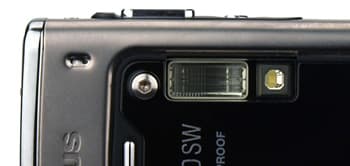
This tiny flash isn't very effective.
**
**Zoom Lens(2.75)
The zoom runs from 5.0 – 18.2 mm (28 – 102mm equivalent on a 35mm camera), which is slightly more than 3.6x. The zoom occurs within the camera body itself – there's no lens snout sticking out of the 1030 SW, which helps keep it pocket-friendly. The aperture ranges from f/3.5 at the widest setting to f/5.1 at the maximum telephoto length. That's not a spec to delight available light photographers. The lower the aperture number, the more light the camera lets in, and f/3.5 is pretty high. And a higher aperture means you'll need a slower shutter speed to achieve proper exposure, increasing camera shake and image noise. By comparison, the 12x zoom Canon PowerShot S5 IS offers a maximum aperture of f/2.7.

The lens is well protected by a solid frame.
Zoom level is controlled using two small buttons at the top right of the camera back. This isn't a smooth, precision zoom mechanism, though. Each time you press the button the lens jumps to another preset zoom position – the optical zoom range offers nine steps in all. The response to each button press is snappy enough, and there's none of the annoying back-and-forth lens movement after zooming we've found on some inexpensive point-and-shoots. You're not getting a lot of fine control when re trying to carefully frame a photo using this system, though.
Unlike other cameras in this price range, the 1030 SW doesn't offer true image stabilization technology, either via a shifting lens component or a sensor that adjusts to camera movement. The 'digital image stabilization' system works by boosting ISO settings and shutter speed, which we hesitate to label as image stabilization at all.

This Murakami sculpture was shot from the same spot with the lens at 5mm,10mm and 18mm.
**
**
Design / Layout
Model Design / Appearance*(8.00)*
Olympus has succeeded in creating a handsome pit bull of a camera. The visible screw heads, the prominently framed lens and nicely curved edges give it a solid industrial look with a hint of design finesse. The design matches the functional promise of the camera, which we applaud.
Size / Portability (7.50)
All the shockproofing, waterproofing, and near bullet-proofing Olympus has used to gird the camera's photographic loins against the elements also serves to boost the weight-to-size ratio beyond at-a-glance expectations. The 1030 SW looks fairly petite at 3.7 x 2.4 x 0.84 inches (93.6mm x 60.9mm x 21.3mm), but it weighs in at a solid 6.3 ounces (170g) without a battery. Considering the intended usage in rugged environments by daring, adventurous folks, we're fine with that – a camera built to withstand the elements should have some heft in the hand. On the other hand, if you like to wear low-slung jeans, the weight of the 1030 SW just might lead to some embarrassing surprises if you carry the camera in your pocket.
Handling Ability(8.00)
We found the 1030SW comfortable to hold, at least with two hands. The weight and balance make it tough to hold securely for a one-handed grab shot, but those shooting situations are few and far between in our experience anyway. With our left and right thumbs supporting the camera from below, left index finger resting on the top of the camera and right index poised on the shutter release, we had no trouble point-and-shooting quickly and accurately. The prominent lens housing makes a nice extended finger rest on the left side, affording a little extra stability when using the right thumb to adjust the cluster of controls. There's little danger of obstructing the lens or the flash with a stray fingertip, a common flaw with compact cameras. For a camera designed to be used in potentially challenging shooting situations, Olympus has done an excellent job providing secure, simple handling.
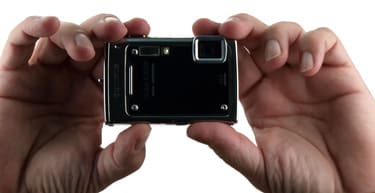
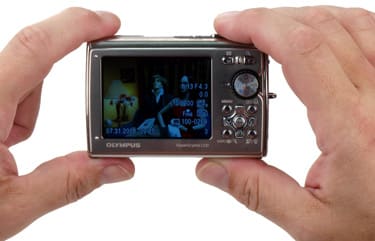
The 1030 SW is small but still easy to handle,
even for editors with large paws.
**Control Button / Dial Positioning / Size **(7.75)
The control layout is a bit cramped, but we found that learning the system was reasonably straightforward and, once learned, we could make adjustments quickly and efficiently.
The lens zoom buttons also serve to zoom in and out during image playback and, when zoomed out beyond full-size display, to bring up a thumbnail image display, progressing from four to nine to sixteen images to twenty-five images on the screen and, finally a calendar display with photos neatly arranged according to the day they were taken.
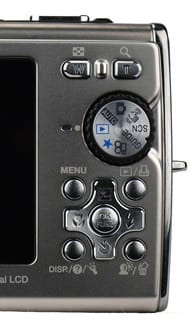
Controls are packed in tightly.
The dial below the zoom controls moves smoothly and firmly enough into eight positions. These are:
AUTO: full auto mode
Program: indicated by a black camera icon, program mode offers automatic exposure control while allowing the user to change white balance, ISO, burst mode, metering mode, image size and compression settings
Anti-shake: essentially full-auto mode with automatic ISO boost to counteract camera shake
SCN: brings up a choice of 24 scene modes (see below). If the highlight remains on a scene mode icon, a text description automatically appears.
GUIDE: a mode that lets users set shooting parameters based on a textual descriptions and on-screen images previewing the impact of available decisions
Movie Mode: indicated by a movie camera icon
My Favorite: indicated by a blue star icon, displays photos you've pre-selected as your top picks
Play: indicated by the familiar VCR play icon, printed in blue
The lower third of the right control panel presents an array of buttons that may appear intimidating at first glance, but in practice works well. In the middle is the four-way controller, with its OK/FUNC button in the middle and arms that call up exposure compensation, flash mode, self-timer and macro mode controls when not navigating an on-screen menu. Pressing the center button while shooting brings up the useful shortcut menu (see below).
Tucked into the otherwise empty space between these arms are four little round buttons – waste not, want not when it comes to available space on a compact camera. Moving clockwise from the top left these are Menu, Play/Print, Backlight Compensation/Erase and Display/Help/LED. While that sounds like a lot of baggage for a few buttons to carry, the functions sort themselves out based on how you're using the camera at a given moment. If you're shooting and hit the Play/Print button, it brings up an image review screen for previous shots. If you're in playback mode and connected to a printer, the same button brings up direct print controls. The backlight compensation/image erase button is equally clear in context – mostly. Hold down this button long enough and there's a surprise treat: an onscreen Button Guide that adds precisely no information to your understanding of what's right in front of you already. A fine entry in the Worthless Features Hall of Fame.
That last button, in the lower left corner, also has a peculiarity or two. During playback mode it toggles between a variety of on-screen displays – fair enough. While navigating on-screen menus, it pops up informational text captions – again, pretty useful. Hold it down long enough, though, even if the camera is off, and the LED illuminator (ordinarily used to light up objects within macro range, instead of blowing them out using flash) turns on. Maybe this is meant to be a find-your-car-keys mode, but as far as we're concerned it's headed straight to the aforementioned Hall of Fame.
A little good-natured taunting aside, the 1030 SW control system is mostly well designed, with buttons that respond well to an intentional press but aren't easy to trigger accidentally.
Menu (6.50)
The menu system combines a number of nested branches, attempting to bring the most frequently used controls to the screen as quickly as possible. For the most part, the design succeeds.
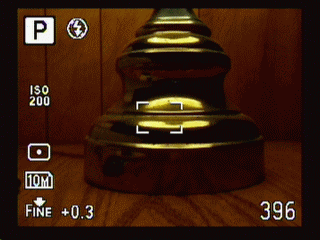
This convenient shortcut menu keeps
frequent adjustments readily available.
Top of the list in this regard is the record-mode shortcut menu that appears when you press the OK/FUNC button. In program mode (where you'll do most of your shooting) it brings up a concise listing down the left side of the screen with white balance, ISO, shooting mode, metering mode, image size and compression setting, each of which presents a fly-out menu across the screen as you toggle the highlight downward. In practice, we almost never had to press the MENU button and work out way through sub-menus thanks to this quick-access set-up. In AUTO mode, only image size and compression settings are available from ths menu.
Beyond this shortcut control, the standard camera menus work as follows:
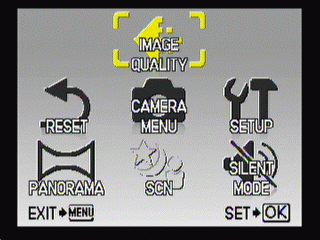
In Auto mode, only Image Quality, Setup and Silent Mode are available.
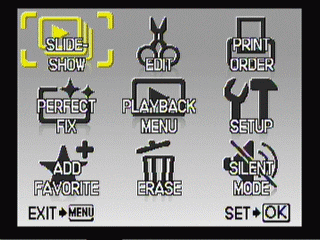
Ease of Use (7.75)
Olympus has gone out of its way to festoon the camera with helpful features. Straight automatic point-and-shoot works well out of the box, and program mode adds a reasonable step-up in hands-on control. The abundance of preset modes, with their on-screen icons plus text explanations of their functions, are nicely designed, and the Guide system, providing text menus to guide the user through camera setting selections, is also strong. We like the use of the Display button to bring up annotations explaining menu-system choices too. The most severe limitation to the camera’s ease of use, in fact, is that there aren’t more manual controls available to tailor the picture-taking experience. The same generous helping-hand system applied to a camera that allows aperture and shutter selection, custom white balance setting and manual focus would be much appreciated.
If you don't want to deal with confusing icons,
you can read your way to the right setting.
Modes
Auto Mode (8.50)
Selecting full auto mode resets everything to camera defaults, imposes automatic white balance and ISO control, mandates single-shot mode and ESP (balanced) light metering. The user can still adjust image size and compression, and use the four-way controller to adjust flash mode, macro mode, exposure compensation and self-timer settings. It's a reasonable balance: it's unlikely a newbie will accidentally mess up any significant settings with the camera in Auto mode, but several key adjustments are just a few presses away.
**Movie Mode **(4.25)
The 1030 SW shoots Motion JPEG movies (stored as AVI files) at either VGA (640x480) or QVGA (320x240) resolution, at 15 or 30 frames per second. Given the camera's substantial underwater credentials, it makes sense that it offers both dry-land and submerged movie modes, though we did find the labeling of everyday video mode as NON-WATER MOVIE (contrasted with UNDERWATER MOVIE in the menu) fairly amusing. We were briefly baffled by the fact that non-water movie mode allows you to record sound but not use the optical zoom while shooting, while underwater mode allows the zoom but prohibits sound recording. Then we listened more closely to the camera while zooming – the sound of gears turning as the internal zoom moves inside the camera would be audible on your movie soundtrack.
Within the scene mode selection is an additional movie-shooting option called PRE-CAPTURE MOVIE, which keeps
2 seconds of video in an ongoing buffer and includes it with the video captured after the shutter is pressed.
Drive / Burst Mode*(6.00)*
There are three drive mode settings beginning, as expected, with single-shot. Normal sequential shooting proceeds at the current image resolution setting, locking focus and exposure with the first frame and capturing a non-blistering 0.7 frames per second for up to seven frames at full 10-megapixel resolution. If you're willing to compromise on resolution, you can take a far more impressive 5.2 frames per second, for up to 11 frames, at 3-megapixel resolution using the Hi mode setting.
**Playback Mode ***(8.75)*
The on-screen view of photos you've taken can be toggled between five different display layouts using the DISP button.

There are five playback mode displays.
Normal display: overlays image size and compression setting, file name, image number, date and time taken
Detailed display: adds shutter speed and aperture, exposure compensation, ISO and white balance settings to the normal display
No information display: a clean screen, showing the photo with no overlay
Histogram display: A thumbnail of the photo at top left, a histogram showing over- and under-exposed areas on the lower left, date and time taken under the histogram and, on the right, information on shutter speed and aperture, exposure compensation, ISO, white balance, compression setting, image size and image number. Not shown when a movie is selected.
A basic slideshow utility lets you choose from showing all or only selected images and what kind of animated transitions appear between photos.
There's also a Favorites mode, which transfers an image to the camera's built-in memory, making it instantly accessible for playback by turning the control dial to the star icon.
Custom Image Presets*(11.00)*
There are 24 preset modes available by turning the control dial to SCN. The extensive help system implemented in the 1030 SW works especially well here: while browsing through the scene mode display, pressing the DISP button (or simply leaving the display unchanged for a few seconds) brings up a brief text explanation of the preset's functions.
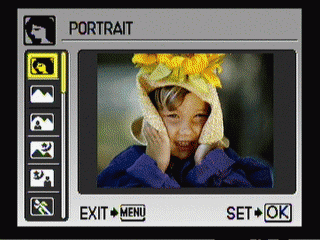
There are lots of clearly labeled custom presets.
In addition to the obvious modes (portrait, landscape, sports, fireworks), there are some more unusual choices among the 24 selections. Four are designed for shooting underwater (Underwater Snapshot, Underwater Wide 1 for landscape shots, Underwater Wide 2 for action scenes and Underwater Macro for watery close-ups). The Auction selection captures 3 photos in a row, sizing them differently for use in online auction postings. There are two Shoot & Select modes. The first engages the lower-res 0.7 frames per second burst mode and, when you're done shooting, displays the results on screen to let you choose which images to save and which to discard. The second Shoot & Select mode sticks with slower, full-res images, even firing the flash if needed, then offers the same keep-it-or-kick-it display. Pre-Capture Movie is an oddball option, constantly keeping 2 seconds of video in a buffer, then adding an additional 5 seconds after you press the shutter and ultimately saving the completed 7-second sequence. Even Attention Deficit Theater fans may find the seven-second running time a bit terse.
Control Options
Manual Control Options
Manual control options are few and far between on the 1030 SW – in fact, we couldn't find the word 'manual' in the manual beyond the cover page. There is no manual focus option, or manual exposure setting (no full-manual, no shutter- or aperture-priority setting), and no manual white balance setting, for that matter. Beyond tweaking exposure compensation, the camera is pretty much in charge.
**
Focus**
Auto Focus (6.00)
There are three auto focus options:
Spot: focus on the subject in the center of the frame
iESP: the camera identifies the dominant subject anywhere in the frame and focuses on that
Face Detect: the camera finds a face and sets focus and exposure on that basis
Auto focus performance is middle-of-the-road for a point-and-shoot camera. In bright light it's quite fast and reliable. As you move indoors into dimmer environments performance degrades rapidly – focusing in your Mom's living room will be a bit pokey but workable, focusing in a night club or romantic restaurant will fail as often as it succeeds.
Manual Focus (0.00)
Move along, move along…no manual focus here.
ISO (9.75)
ISO settings range from 80 to 1600. That ISO 80 setting is unusual and, considering the fact that the next step up is 100, a bit surprising. On the other hand, we did find that using that one-skinch-lower setting did result in a slight but undeniable improvement in a few key performance testing areas, including noise and dynamic range.
White Balance (6.50)
In addition to Auto there are six manual white balance settings: sunlight, shade, incandescent, fluorescent1, fluorescent2 and fluorescent3. It would have been helpful if the labeling for these three fluorescent settings, either on-screen or in the manual, indicated which types of fluorescent bulbs correspond to which setting. On the other hand, the LCD display image changes color as you switch white balance settings, so you can eyeball your choice with reasonable accuracy, and three settings is generous. There is no flash white balance setting, and no way to set white balance manually, a feature we expect to find on a $400 camera, especially one designed for physically challenging environments that may pose unusual lighting situations.

Changes to the white balance setting are
immediately reflected on-screen.
Exposure (2.50)
Exposure compensation is handled well. Settings range from -2EV to +2EV in 1/3EV increments, which is fairly standard. However, we like the fact that exposure compensation is easy to reach (by pressing the top tab of the four-way controller) and the on-screen display with four thumbnail images reflects the effect of each exposure compensation possibility.
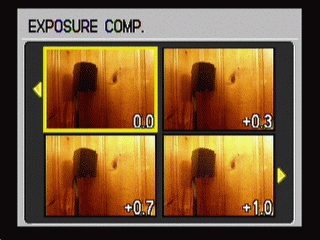
The results of exposure compensation changes
are previewed on the LCD.
Metering (4.75)
There are two metering modes. Spot, as always, measures the lighting at the center of the frame and sets exposure accordingly, while ESP balances the center with the surrounding area. When using face detection focusing, exposure metering is based on the found faces as well.
Shutter Speed (6.00)
Basic shutter speeds range from 1/1000 second to 1/2 second, though this can be extended to 4 seconds in the Night Scene preset mode. This is not an impressive spec: the Panasonic LZ8, for example, sells for less than half the price, but offers shutter speeds from 1/2000 second to 8 seconds, and lets you manually control them as well, a feature the 1030 SW lacks.
Aperture (3.50)
The aperture range runs from f/3.5 to f/5.1, which is troubling on the low end. The smaller that first aperture number, the more light can get through the lens and hit the sensor. In this case, low-light photography is significantly impaired by poor lens performance – the automatic system constantly attempts to fire the flash to compensate, which not only leads to poor lighting and intrusive photography but also drains the already-strained battery. By comparison, the Canon A650 IS aperture starts at f/2.8, the Nikon Coolpix P5100 at f/2.7, and the inexpensive Panasonic LZ8 at f/3.3.
Image Parameters
Picture Quality / Size Options (4.30)
The 1.1cm CCD image sensor, with 10,700,000 gross pixels, provides 10.1-megapixel resolution in standard 4:3 format.
Seven image size options are available:
There are also two compression settings: Fine and Normal.
Picture Effects Mode (2.75)
There are no picture effects that can be applied during shooting, but several options are availble for altering images during playback, in Edit Mode. These include:
Edit: Save an additional, smaller version of the photo at (640x480 or 320x240 resolution)
Crop: Choose one of four sizes (two landscape, two portrait orientation), though the cropping box can be moved around the screen.
Color Edit: Create a copy in black and white, sepia, or one of two increased saturation settings
Frame: Inset your chosen photo into one of thirteen frame designs. See the image below and judge for yourself whether any of these options is in any way attractive.
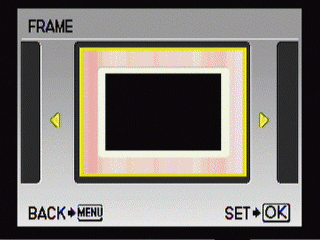
Retro design reigns in the Frame feature.
Label: Overlay one of ten text messages (Congratulations, Thank You, Happy Birthday, etc.) over a photo you’ve shot. The label text can be white, black or a shade of gray, and resized and repositioned over the image.
Calendar: Insert a photo you’ve taken with one of eight calendar layouts to create a combined page for printout.
Index: Available during movie playback, the Index function takes nine frames and turns them into thumbnails combined in an index image that provides an overview of the movie clip.
Also available from the Playback menu are two image enhancement functions under the heading Perfect Fix. Shadow Adjustment brings up the lighting in dark areas and creates a new copy of the image with the enhancement applied. There is no user control over how much or how little the shadows are boosted. Redeye Fix is also available, again as an automated function with no user control.
During shooting, the 1030SW offers three different options for shooting panoramic images:
Combine in Camera 1: Take your first photo. As you move the camera left or right, a point and a target marker appears on screen. When you line up the pointer with the target marker, the camera automatically takes a second picture. Follow the same procedure for the third shot and the camera combines the three images and saves the result. The three shots aren’t saved individually. And if you want to take just a two-image panorama, pressing Menu after the second shot does the trick.
Combine in Camera 2: You take three shots manually. After each photo a panel on one side remains visible as a reference for moving the camera and lining up properly for the next shot. When three photos have been taken, the camera stitches them together and saves the result.
Combine in PC: You have more freedom when shooting images to be combined using the OLYMPUS Master 2 software provided with the camera. You can shoot up to ten images to be combined, and can pan not only horizontally but vertically as well. However, there’s no handy on-screen reference helping you line up the next shot properly, as you have in the previous two modes, so you’re relying on the computer software’s superior processing capability to make up for your less accurate panoramic shooting.
Connectivity / Extras
Connectivity
Software (6.50)
The CD-ROM that comes with the camera includes versions of OLYMPUS Master 2, an image organizing and editing program, for both Windows and Mac. Windows users also receive a trial copy of muvee theaterPack, a rudimentary automated movie editing program that expires after 15 days – how will those poor Mac owners control their jealousy? The OLYMPUS Master 2 program, though, is far more useful than most of the software we receive free with digital cameras. In addition to basic image organizing and viewing capabilities, OLYMPUS Master 2 supports automated photo email creation and YouTube uploading, and provides extensive photo editing capabilities, including automatic and manual adjustment of brightness and contrast, color balance, hue and saturation, image sharpening, and even lens distortion correction to adjust for pincushioning and barrel distortion.
Jacks, ports, plugs (2.00)
There’s one proprietary port used to connect two included cables for USB connectivity and video output. The AV cable supports composite video and one channel of audio. Requiring a proprietary USB cable on this camera is especially problematic, since card readers that handle the xD card format are a rarity. If you lose the Olympus cable, you're going to have trouble off-loading your pictures.
Direct Print Options (3.50)
The in-camera software used to printing directly from the 1030 SW to a PictBridge-compatible printer connected via USB offers three useful features not found on many compact cameras: the ability to print several images on a single sheet of paper, the option to print pages of thumbnail-sized images to serve as index prints, and image cropping before printing. More importantly, the menu structure and on-screen displays are easy to use, which counts for a lot. There are two direct print modes. Easy Print simply outputs a single copy of the picture shown on the LCD, using the printer default settings. Custom Print lets you choose paper size, specify bordered or borderless printing, choose from single or multi-image printing, create an index print, set the number of prints for each image and decide whether to overlay file name and/or date on the print.
You also have the option to create a DPOF print order, which specifies settings for printing at a kiosk or commercial printing service, or on a DPOF-compatible home printer.
Battery (5.00)
The 1030 SW uses a slender LI-50B lithium ion rechargeable battery, which Olympus says will last about 260 shots per charge. That may sound like plenty but, during our testing, we found the battery would poop out long before the day was over. If you’re planning to carry this camera to capture once-in-a-lifetime photo opportunities, we’d strongly recommend packing a spare battery (a $31 investment on Amazon). Also worth noting: there's no keying system when inserting the battery, meaning it goes in upside down as easily as right-side-up. Getting it right requires peering into the battery compartment and looking for the connectors, a significant inconvenience.

The slim battery and xD card share a bottom compartment.
*
Memory* (2.50)
There’s a modest 14.7MB of internal memory built into the camera – beyond that, you’re looking at an investment in xD-Picture Cards, an Olympus proprietary memory format currently available with a maximum storage capacity of 2 gigabytes. We can’t really come up with an advantage to using xD cards – they can’t come close to the enormous capacities of SDHC cards (now at 32 gigabytes), and sell for a higher price per capacity than SD cards. Radio Shack, for example, sells a 2-gigabyte SanDisk xD card for $34.99, while a 2-gigabyte SanDisk SD card goes for $14.99. The camera comes with an adapter that enables it to accept microSD cards, the type ordinarily used in cellphones. Here again, unless you happen to have a stash of microSD cards with nothing better to do, we would prefer using standard, inexpensive, high-capacity SD cards, like most compact cameras.**
Other features**(12.00)
Torture and Abuse Resistance: Ordinarily our carefully orchestrated digital camera evaluation procedure doesn’t include physically abusing the equipment, so the very heart of the 1030 SW’s appeal lies here, at the tail end of our review. Olympus makes four significant promises regarding the camera’s ability to stand up to harsh conditions:
Waterproof to a depth of 33 feet (10 meters) for an hour
Freezeproof down to 14 degrees Fahrenheit (-10 Celsius)
Shockproof to withstand a 6.6-foot (2 meter) drop
Crushproof to withstand 220 pounds of pressure
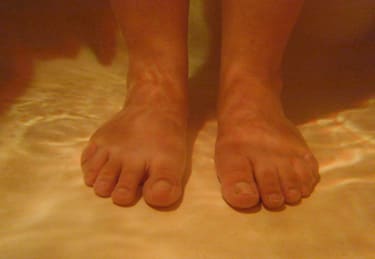
We shot two feet underwater with the 1030 SW,
though it's safe to use at 33-foot depths.
Since our staff lacks professional divers to take our test camera down to a 30-foot depth, we tried the 1030SW in more readily available environments (a pool, a bathtub and an unoccupied aquarium tank) with excellent results. After years of guarding our cameras against the elements, it seemed incredibly intimidating at first to dunk a camera in H2O. It quickly became clear, though, that Olympus had delivered on its waterproof promise. All seals held, even after violent jostling, and the camera emerged unscathed.
Temperature torment was also inflicted using the water bath technique. A cooler full of water, ice and salt was brought down to roughly the 14-degree mark and the camera was immersed. Again, it emerged, Houdini-like, none the worse for wear.
Shockproof was relatively easy to test. We started tentatively, with a fall to a carpeted surface, but finally graduated to a linoleum floor. The 1030 SW plummeted, bounced slightly, and continued to function.
Finally, a heavyset editor's back pocket was used to test grace under pressure. The 1030 SW survived the indignity unscathed.*
**Manometer: *To be honest, we thought a manometer was something you bought from an ad in the back pages of Cosmo until we encountered it in the camera manual. Turns out it displays the atmospheric pressure and altitude/depth while shooting, ranging from -32.8 feet (-10 m) to 16,400 feet (5000 m). This would be a far more useful feature if you could actually record the reading along with your photograph, but it's still worth having.
Overall Impressions
Value (7.00)
This is a camera you're going to buy for its distinctive element-defying capabilities, and the more you make use of them, the better the $400 price looks. For its intended audience, then, we give the 1030 SW high marks for value.
Comparisons
None of the cameras featured here offers the ruggedized performance of the 1030 SW. With that as a given, though, let's look at how they compare based on photographic performance, feature set and value.
[

](https://www.reviewed.com/cameras/content/Canon-PowerShot-S5-Digital-Camera-Review-15596.htm)
**Canon PowerShot S5 IS – **While it originally shipped for $500, the PowerShot Shot S5 IS today lists at $349.99, $50 less than the 1030 SW. Your investment buys you an 8-megapixel camera with a 12x optical zoom lens and optical image stabilization, an important capability the Olympus lacks. With its fast f/2.7 lens, impressive color and white balance performance and solid construction, the PowerShot is a heavyweight performer. It's also a heavyweight camera, though, at just under a pound, giving the 6.3-ounce 1030 SW a significant edge in portability.
[

](https://www.reviewed.com/cameras/content/Nikon-Coolpix-P5100-Digital-Camera-Review-16525.htm)
***Nikon Coolpix P5100* – **This Nikon is a 12.5-megapixel compact (compared to the 10-megapixel 1030 SW resolution) with a 3.5x optical zoom lens. It's also roughly the same size and weight as the Olympus, at 7.1 ounces, though the shape is more sculptured for easy gripping. Priced at $50 less than the 1030 SW, the P5100 offers the full gamut of manual controls that the 1030 SW lacks, along with a more sophisticated auto focus system and optical image stabilization.
[

](https://www.reviewed.com/cameras/content/Panasonic-Lumix-DMC-LZ8-Digital-Camera-Review-18483.htm)
Panasonic DMC-LZ8**–**Priced at just $180, the DMC-LZ8 is an 8-megapixel point-and-shoot with a 5x optical zoom lens. While billed as an entry-level camera, it nevertheless incorporates aperture-priority, shutter-priority and full manual modes, plus optical image stabilization, all sorely lacking in the 1030 SW. The build quality of the Panasonic, though, has the cheap plastic feel we expect from budget cameras versus the solid sturdiness of the Olympus.
.
[

](https://www.reviewed.com/cameras/content/Pentax-Optio-Z10-Digital-Camera-Review-16815.htm)
Pentax Optio Z10**–**The $249 Optio Z10 is an 8-megapixel model, roughly the same size as the Olympus, but boasting a 7x optical zoom lens. Also like the Olympus, it lacks true image stabilization technology, relying on ISO boosting instead. In our lab testing, though, the 1030 SW turned in superior performance in nearly every way (only white balance was so bad the Pentax emerged victorious).
**Who It’s For ***
Point-and-Shooters* – The utter simplicity, extensive preset modes and helpful on-screen guidance while shooting make this an attractive choice for those looking for an easy-peasy camera. It's tough to recommend versus lower-priced competition, though, unless you're yearning for the simple life combines with an urge to put body and camera alike through wet, wild and/or freezing cold adventures.
Budget Consumers – $400 for a point-and-shoot seems like an instant budget-buster. On the other hand, if you're headed for environs where an unprotected camera ordinarily wouldn't be welcome, this compact companion could be a superior choice compared to investing in a waterproof case and then lugging the cumbersome rig with you.
Gadget Freaks – In a sense, the camera's ruggedness qualifies it as a gadget, and it certainly comes with some bragging rights versus your friends' namby-pamby gear.
Manual Control Freaks – Not a chance
Pros / Serious Hobbyists – Only as a second camera specifically for high-impact situations.
Conclusion
**
Conclusion**
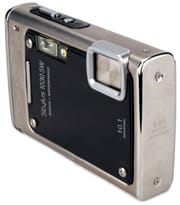
The Olympus 1030 SW is both a treat and a disappointment. We love the idea of a camera we can mistreat in a wide range of difficult shooting situations without having to worry about babying our gear. It's small and portable enough to go where an SLR would be a burden, and easy to handle quickly, even if you're wearing gloves (we tried) or warding off barracuda (we didn't, but we're confident nonetheless). And while image quality wasn't stellar, it was certainly acceptable for a compact camera.
It would have been so much better, though, if the 1030 SW incorporated a few features that are really standard on most modern digital cameras. Top of the list is image stabilization, especially for a camera designed for on-the-go shooting. The ability to set the shutter speed manually for fast-action shooting, or to close down the aperture to extend the focal distance for a scenic shot would have been worthwhile additions. Bottom line: recommended for adventure-loving amateur photographers, but with reservations.
Sample Photos
**Sample Photos
Click on any of the images below to view the full-sized original image. However, please note that some of the images are extremely large (up to several megabytes) and could take a long time to download. **
**
You can browse photos taken with the Olympus Stylus 1030 SW at the following photo hosting sites.******
[

](http://search.fotki.com/?q=1030)[

](http://www.smugmug.com/search/index.mg?searchWords=1030&searchType=global&x=0&y=0) [

****](http://flickr.com/search/?q=1030sw)
Specs / Ratings
**Specs Table
**{{manufacturer_specs_table}}{{raw_scores_table}}
Meet the tester

Steve Morgenstern
Editor
Steve Morgenstern is a valued contributor to the Reviewed.com family of sites.
Checking our work.
Our team is here to help you buy the best stuff and love what you own. Our writers, editors, and experts obsess over the products we cover to make sure you're confident and satisfied. Have a different opinion about something we recommend? Email us and we'll compare notes.
Shoot us an email